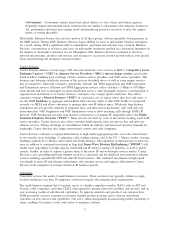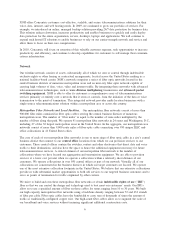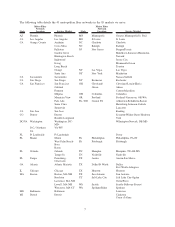XO Communications 2009 Annual Report Download - page 19
Download and view the complete annual report
Please find page 19 of the 2009 XO Communications annual report below. You can navigate through the pages in the report by either clicking on the pages listed below, or by using the keyword search tool below to find specific information within the annual report.Glossary
In order to assist the reader in understanding certain terms relating to the telecommunications industry that are
used in this report, a glossary is included.
3G. The third generation of mobile phone standards and technology. 3G technology enables network
operators to offer users a wider range of more advanced services while achieving greater network capacity
through improved spectral efficiency. Services include wide-area wireless voice telephony and broadband
wireless data, all in a mobile environment. Typically, they provide service at 5-10 megabits per second.
4G. A term used to describe the next step in wireless communications. A 4G system will be able to
provide a comprehensive IP solution where voice, data and streamed multimedia can be given to users at
higher data rates than previous generations.
Access Charges. The fees paid for the local connections with carriers’ networks.
Advanced Packet Switching Equipment. Packet switches based on technologies such as IP, MPLS, or
Ethernet that typically provide multiple classes of service, connection-oriented services, significant
operations and maintenance functionality, and rapid protection switching.
Asynchronous Transfer Mode, or ATM. An information transfer standard that is one of a general class of
packet technologies that relay traffic at varying rates, permitting a mix of data, voice and video.
Backbone. A high-speed network that interconnects smaller, independent networks. It is the through-
portion of a transmission network, as opposed to spurs which branch off the through-portions.
Backhaul. A telephone or data transmission from a remote network to a main or central site.
Bandwidth. The difference between the upper and lower cutoff frequencies of, for example, a filter, a
communication channel, or a signal spectrum, and is typically measured in hertz. Also, the capacity of a
communications channel, typically measured in bits per second (bps).
Capacity. The information carrying ability of a telecommunications facility.
Carrier. A company which provides communications circuits.
Central Offices. A telecommunications center where switches and other telecommunications facilities
are housed. CLECs may connect with ILEC networks either at this location or through a remote location.
Competitive Local Exchange Carrier, or CLEC. A company that provides local exchange services,
including dedicated service, in competition with ILECs.
Collocation. Central offices within our local markets where we can interconnect our network to an
ILEC’s network by extending our facilities to the ILEC’s central office and placing telecommunications
equipment in the ILEC’s office.
Conduit. A pipe usually made of metal, ceramic or plastic, that protects buried cables.
Dark Fiber. Unused fiber through which no light is transmitted or installed fiber optic cable not carrying
a signal.
Dedicated. Telecommunications lines dedicated to, or reserved for use by, a particular customer along
predetermined routes.
Dense Wave Division Multi-plexing, or DWDM . A means of increasing the capacity of fiber-optic data
transmission systems through the multiplexing of multiple wavelengths of light.
Digital. A means of storing, processing and transmitting information by using distinct electronic or
optical pulses that represent the binary digits 0 and 1. Digital transmission and switching technologies use
a sequence of these pulses to represent information as opposed to the continuously variable analog signal.
The precise digital numbers preclude distortion (such as graininess or snow in the case of video
transmission, or static or other background distortion in the case of audio transmission).
15
























